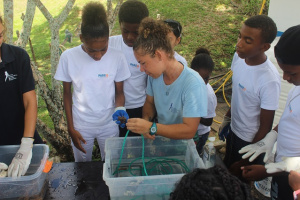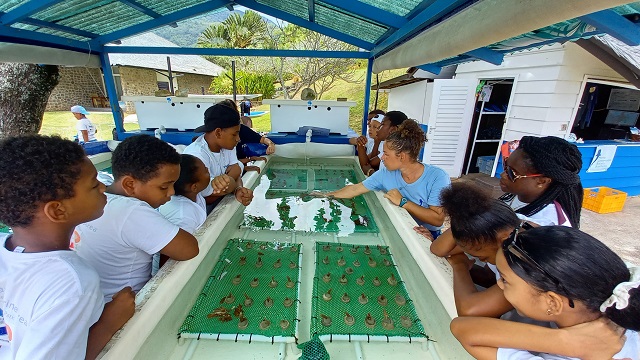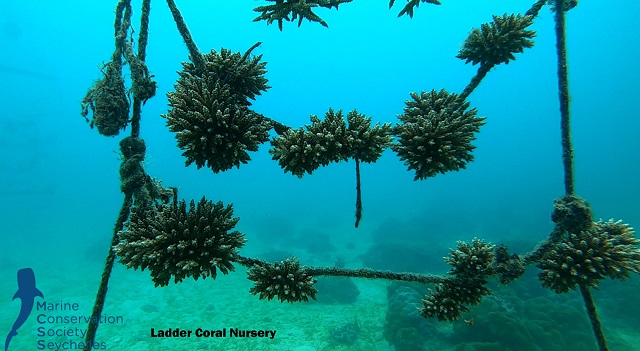PAREO: MCSS educates students in Seychelles about coral restoration
Conservation |Author: Irene Dupreez Edited By: Betymie Bonnelame | August 20, 2023, Sunday @ 08:08| 18905 views
The children were thrilled to learn about coral restoration. (Marine Conservation Society Seychelles)
A group of children from Praslin Island in the PAREO programme learned more about restoring coral reefs in a whole-day programme organised by the Marine Conservation Society Seychelles (MCSS) recently.
The PAREO's mission, which includes Seychelles, Mauritius, Reunion, and Comoros, is to raise awareness among children and local communities about the protection of coral reefs and move from knowledge to action.
PAREO (le Patrimoine récifal de l'océan Indien entre nos mains - the reef heritage of the Indian Ocean in our hands) is a programme of IRD - the French National Research Institute for Sustainable Development.
The children went on a guided tour of the MCSS coral restoration programme at the Fisherman's Cove Resort at Bel Ombre in the north of Mahe, the main island, led by Yasmine Watkins - scientist and project leader - and project assistant and snorkelling guide, Ira Hoareau.
Watkins showed and explained the two tanks MCSS had on display as a controlled, ideal environment for the coral cuttings and the first nursery of their coral growing venture.
One tank was with corals of opportunity and another contained very resistant corals. Both tanks are kept in perfect condition with everything a coral needs to speed up their growth rate. When reaching a sufficient size, the corals from both tanks are attached to a line, and placed on in-water nursery ladders situated near the reef in the sea. The healthy new corals can grow further to a stately size and then be replanted on vulnerable reefs and places where once reefs protected the shores.
 |
| The children went on a guided tour of the MCSS coral restoration programme at the Fisherman's Cove Resort at Bel Ombre. (Marine Conservation Society Seychelles) Photo License: CC-BY |
Watkins said that when taking corals from a healthy resilient reef to create new cuttings, "We use never more than 10 percent of the mother colony; the coral colony has to have a certain size, taking these resilient genes and place them at locations less stressful. That is our goal."
She added that "We also introduce more resilient corals as it gets quite warm, so we choose very resilient coral and try to get them to replace dead or dying corals and grow a healthy reef again. Here, we use coral gardening practises."
"Our tanks are kept in perfect sea condition: we monitor them, and clean macro algae off them, which is a direct competitor for sunlight. However, corals live in harmony with special algae. Shallow water, reef-building corals have a symbiotic relationship with photosynthetic algae called zooxanthellae, which live in their tissues," she added.
The children were thrilled to learn about coral restoration because they had already learned that coral reefs protect coastlines from storms and erosion, provide jobs for local communities, offer opportunities for recreation, and are a source of food and new medicines.
Under a microscope, the students were able to view and compare live and dead corals and got the opportunity to gain a deeper understanding of coral anatomy, their significance in that area and the conservation action they can engage in.
 |
| The Ladder coral nursery. (Marine Conservation Society Seychelles) Photo License: CC-BY |
They also took part in coral fragmentation where they cut bigger corals into smaller sizes to be attached to a rope for the in-water coral nurseries.
It was an activity the children loved and Keinan Esther said: "We like our PAREO programme, today we learned that you can have a coral farm, corals are similar to us, they have skin and they can re-grow their skin when cut. They rely on filtering food from the ocean. That, here they give corals perfect conditions to grow."
Another student Nathan Barra said: "Since I was six years old, I told my mama that I'm going to become a marine biologist!"
Watkins promised the students that when the corals they cut and attached to a rope are placed in the sea and attached to a ladder, they will bear a sign with the name PAREO.
Back
